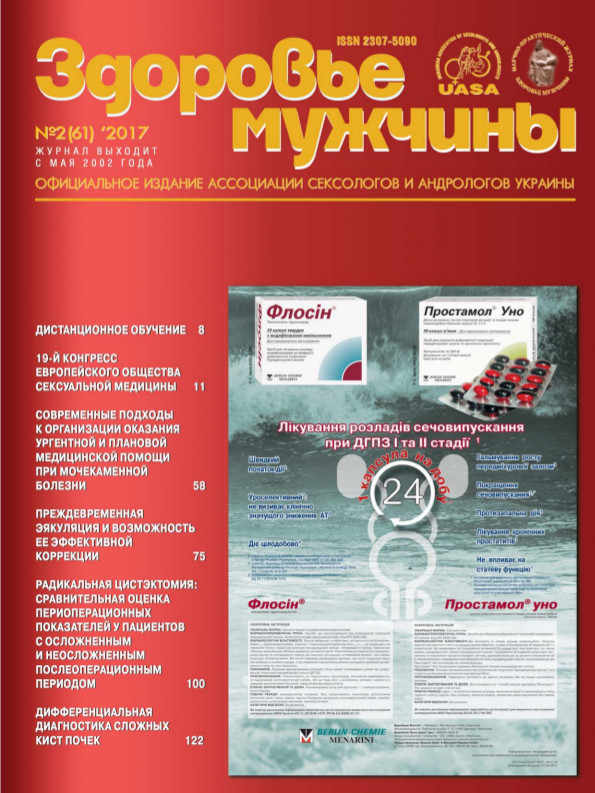The state of free radical oxidation in people with diabetes mellitus, who underwent a minimally invasive treatment of ureterolithiasis
##plugins.themes.bootstrap3.article.main##
Abstract
Patients and methods. The study involved 204 people, of which the male sex was 130 (63,7%), the female – 74 (36,3%). The average age of women is 30,1±2,9 years, men – 37,6±3,1 years. The subjects were divided into VI clinical groups: I (n=57) – persons with DM and ureterolithiasis who underwent TUCL and CA therapy per os; II (n=44) – persons with diabetes and ureterolithiasis, who underwent TUKL without HS therapy; III (n=32) – persons with diabetes and ureterolithiasis who underwent ESWL without HS therapy; IV (n=41) – persons with ureterolithiasis without diabetes who underwent TUCL without HS therapy; V (control 1) – of the person with diabetes, who had an independent passage of stones from the ureter (n=18); VI (control 2) – healthy volunteers, with no signs of pathology (n=12).
Results. The studies were carried out before and after the disintegration of the stones by the method of transurethral contact lithotripsy (TUCL) and ESWL. The purpose of determining the activity of the LPO process according to the level of secondary. The analysis of the parameters of the free-radical oxidation system, the dependence of their changes on the severity of disorders in other links of homeostasis and the stage of diabetic nephropathy, contributes to a more complete assessment of the patient’s condition and the definition of treatment prospects.
Conclusion. Metabolic homeostasis indicators reflect the intense processes of the system of lipid peroxidation and antioxidant protection, in persons with ureterolithiasis and sugar diabetes. In most cases, these changes in homeostasis are decompensated and are characterized by a high risk of developing side-effects, especially when using the ESWL technique, in contrast to the TUCL technique.
##plugins.themes.bootstrap3.article.details##

This work is licensed under a Creative Commons Attribution 4.0 International License.
Authors retain the copyright and grant the journal the first publication of original scientific articles under the Creative Commons Attribution 4.0 International License, which allows others to distribute work with acknowledgment of authorship and first publication in this journal.
References
Сайдакова Н.О., Старцева Л.М., Кравчук Н.Г. Основні показники уролог. допомоги в Україні за 2010–2011 роки: відомче видання / ДУ «Інститут урології НАМУ», Центр мед. стат. – К.: Поліум, 2011. – 199 с.
Довлатян А.А., Касабов А.В. Острый пиелонефрит при сахарном диабете // Урология. – 2003. – No 6. – С. 20–24.
Cattell W.R. Urinary tract infection and acute renal failure. In: Raine A.E., ed. Advanced renal medicine. Oxford: Oxford University Press, 1992. – P. 302–313.
De Cosmo S., Prudente S., Zamaccia O. et al. PPAR-2D12a polymorphism and albuminuria in patients with type 2 diabetes: a metaanalysis of casecontrol studies. – Nephrol. Dial. Transplant. – 2011. – Vol. 26. – P. 4011–4016.
Geerlings S.E., Stolk R.P., Camps M.J. et al. Risk factors for symptomatic urinary tract infection in women with diabetes // Diabetes Care. – 2000. – No 23. – Р. 1737–41.
Дзугкоева Ф.С., Кастуева Н.З., Дзугкоев С.Г. Роль перекисного окисления липидов в патогенезе развития ангиопатий при сахарном диабете. Успехи современного естествознания. – 2005. – No 6. – Р. 95–96.
Зурігат Самер А. Стан ПОЛ у хворих на пієлонефрит при УФО аутокрові // Здоровье мужчины. – 2004. – No 2. – С. 23–25.
Голод Е.А., Даренков А.Ф., Кирпатовский В.И., Яненко Э.К. Перекисное окисление липидов в почечной ткани больных нефролитиазом и хрон. пиелонефритом // Урол. и нефрол. – 1995. – No 5. – С. 8–10.
Голованов С.А., Яненко Э.К., Ходырева Л.А. и др. Диагностическое значение показателей ферментурии, перекисного окисления липидов и экскреции среднемолекулярных токсинов при хрон. пиелонефрите // Урология. – 2001. – No 6. – С. 3–6.
Цветцих В.Е., Крылов В.И., Лернер Г.Н., Бердичевский Б.А. Показатели гомеостаза и функц. cостояние ферментов антиоксидантной защиты при хрон. пиелонефрите // Урология. – 2000. – No 3. – С. 13–15.
Дзеранов Н.К., Яненко Э.К. Оперативное лечение коралловидного нефролитиаза // Урология. – 2004. – No 1. – С. 34–38.
Streem S.B. Long-term incidence and risk factors for recurrent stones following percutaneous nephrostolithotomy or percutaneous nephrostolitotomy: extracorporeal shock wave lithotripsy for infection related calculi // J. Urol. Baltimore. – 1995. – V. 153, No 3 (1). – P. 584–587.
Tashiro K., Iwamuro S., Nacajo H. et al. Stone reccurence after stone free status with extracorporeal shock wave lithotripsy // Nippon Hinyokika and Gakkai Zasshi. – 1997. – V. 88. – P. 434–438.
Фарбирович В.Я., Эйзенах Я.В., Худяшов С.А. Влияние структуры конкрементов на результаты ДЛТ// Урология. – 2001. – No 4. – С. 48–50.
Ошакбаев К.П., Абылайулы Ж., Кожабекова Б.Н. и др. Взаимосвязь эндогенной интоксикации и свободнорадикального окисления при мочекаменной болезни // Урология. – 2007. – No 3. – С. 23–26.





